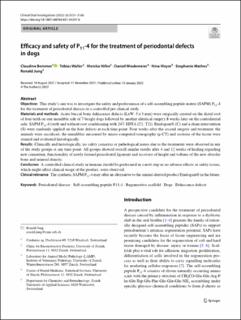Please use this identifier to cite or link to this item:
https://doi.org/10.21256/zhaw-26763Full metadata record
| DC Field | Value | Language |
|---|---|---|
| dc.contributor.author | Bommer, Claudine | - |
| dc.contributor.author | Waller, Tobias | - |
| dc.contributor.author | Hilbe, Monika | - |
| dc.contributor.author | Wiedemeier, Daniel | - |
| dc.contributor.author | Meyer, Nina | - |
| dc.contributor.author | Mathes, Stephanie | - |
| dc.contributor.author | Jung, Ronald | - |
| dc.date.accessioned | 2023-02-06T10:00:56Z | - |
| dc.date.available | 2023-02-06T10:00:56Z | - |
| dc.date.issued | 2022 | - |
| dc.identifier.issn | 1432-6981 | de_CH |
| dc.identifier.issn | 1436-3771 | de_CH |
| dc.identifier.uri | https://digitalcollection.zhaw.ch/handle/11475/26763 | - |
| dc.description | Erworben im Rahmen der Schweizer Nationallizenzen (http://www.nationallizenzen.ch) | de_CH |
| dc.description.abstract | Objectives: This study’s aim was to investigate the safety and performance of a self-assembling peptide matrix (SAPM) P11-4 for the treatment of periodontal disease in a controlled pre-clinical study. Materials and methods: Acute buccal bony dehiscence defects (LxW: 5 × 3 mm) were surgically created on the distal root of four teeth on one mandible side of 7 beagle dogs followed by another identical surgery 8 weeks later on the contralateral side. SAPM P11-4 (with and without root conditioning with 24% EDTA (T1, T2)), Emdogain® (C) and a sham intervention (S) were randomly applied on the four defects at each time point. Four weeks after the second surgery and treatment, the animals were sacrificed, the mandibles measured by micro-computed tomography (µ-CT) and sections of the tissue were stained and evaluated histologically. Results: Clinically and histologically, no safety concerns or pathological issues due to the treatments were observed in any of the study groups at any time point. All groups showed overall similar results after 4 and 12 weeks of healing regarding new cementum, functionality of newly formed periodontal ligament and recovery of height and volume of the new alveolar bone and mineral density. Conclusion: A controlled clinical study in humans should be performed in a next step as no adverse effects or safety issues, which might affect clinical usage of the product, were observed. Clinical relevance: The synthetic SAPM P11-4 may offer an alternative to the animal-derived product Emdogain® in the future. | de_CH |
| dc.language.iso | en | de_CH |
| dc.publisher | Springer | de_CH |
| dc.relation.ispartof | Clinical Oral Investigations | de_CH |
| dc.rights | https://creativecommons.org/licenses/by/4.0/ | de_CH |
| dc.subject | Dehiscence defect | de_CH |
| dc.subject | Dog | de_CH |
| dc.subject | Periodontal disease | de_CH |
| dc.subject | Regenerative scaffold | de_CH |
| dc.subject | Self-assembling peptide P11-4 | de_CH |
| dc.subject | Alveolar bone loss | de_CH |
| dc.subject | Animal | de_CH |
| dc.subject | Bone regeneration | de_CH |
| dc.subject | Dental cementum | de_CH |
| dc.subject | Mandible | de_CH |
| dc.subject | Tooth root | de_CH |
| dc.subject | X-ray microtomography | de_CH |
| dc.subject | Guided tissue regeneration, periodontal | de_CH |
| dc.subject | Oligopeptide | de_CH |
| dc.subject | Periodontal ligament | de_CH |
| dc.subject.ddc | 617: Chirurgie | de_CH |
| dc.title | Efficacy and safety of P11-4 for the treatment of periodontal defects in dogs | de_CH |
| dc.type | Beitrag in wissenschaftlicher Zeitschrift | de_CH |
| dcterms.type | Text | de_CH |
| zhaw.departement | Life Sciences und Facility Management | de_CH |
| zhaw.organisationalunit | Institut für Chemie und Biotechnologie (ICBT) | de_CH |
| dc.identifier.doi | 10.1007/s00784-021-04297-6 | de_CH |
| dc.identifier.doi | 10.21256/zhaw-26763 | - |
| dc.identifier.pmid | 35006293 | de_CH |
| zhaw.funding.eu | No | de_CH |
| zhaw.issue | 3 | de_CH |
| zhaw.originated.zhaw | Yes | de_CH |
| zhaw.pages.end | 3166 | de_CH |
| zhaw.pages.start | 3151 | de_CH |
| zhaw.publication.status | publishedVersion | de_CH |
| zhaw.volume | 26 | de_CH |
| zhaw.publication.review | Peer review (Publikation) | de_CH |
| zhaw.author.additional | No | de_CH |
| zhaw.display.portrait | Yes | de_CH |
| Appears in collections: | Publikationen Life Sciences und Facility Management | |
Files in This Item:
| File | Description | Size | Format | |
|---|---|---|---|---|
| 2022_Bommer-etal_Efficacy-and-safety-P11-4-periodontal-defect-treatment-dogs.pdf | 2.85 MB | Adobe PDF |  View/Open |
Show simple item record
Bommer, C., Waller, T., Hilbe, M., Wiedemeier, D., Meyer, N., Mathes, S., & Jung, R. (2022). Efficacy and safety of P11-4 for the treatment of periodontal defects in dogs. Clinical Oral Investigations, 26(3), 3151–3166. https://doi.org/10.1007/s00784-021-04297-6
Bommer, C. et al. (2022) ‘Efficacy and safety of P11-4 for the treatment of periodontal defects in dogs’, Clinical Oral Investigations, 26(3), pp. 3151–3166. Available at: https://doi.org/10.1007/s00784-021-04297-6.
C. Bommer et al., “Efficacy and safety of P11-4 for the treatment of periodontal defects in dogs,” Clinical Oral Investigations, vol. 26, no. 3, pp. 3151–3166, 2022, doi: 10.1007/s00784-021-04297-6.
BOMMER, Claudine, Tobias WALLER, Monika HILBE, Daniel WIEDEMEIER, Nina MEYER, Stephanie MATHES und Ronald JUNG, 2022. Efficacy and safety of P11-4 for the treatment of periodontal defects in dogs. Clinical Oral Investigations. 2022. Bd. 26, Nr. 3, S. 3151–3166. DOI 10.1007/s00784-021-04297-6
Bommer, Claudine, Tobias Waller, Monika Hilbe, Daniel Wiedemeier, Nina Meyer, Stephanie Mathes, and Ronald Jung. 2022. “Efficacy and Safety of P11-4 for the Treatment of Periodontal Defects in Dogs.” Clinical Oral Investigations 26 (3): 3151–66. https://doi.org/10.1007/s00784-021-04297-6.
Bommer, Claudine, et al. “Efficacy and Safety of P11-4 for the Treatment of Periodontal Defects in Dogs.” Clinical Oral Investigations, vol. 26, no. 3, 2022, pp. 3151–66, https://doi.org/10.1007/s00784-021-04297-6.
Items in DSpace are protected by copyright, with all rights reserved, unless otherwise indicated.